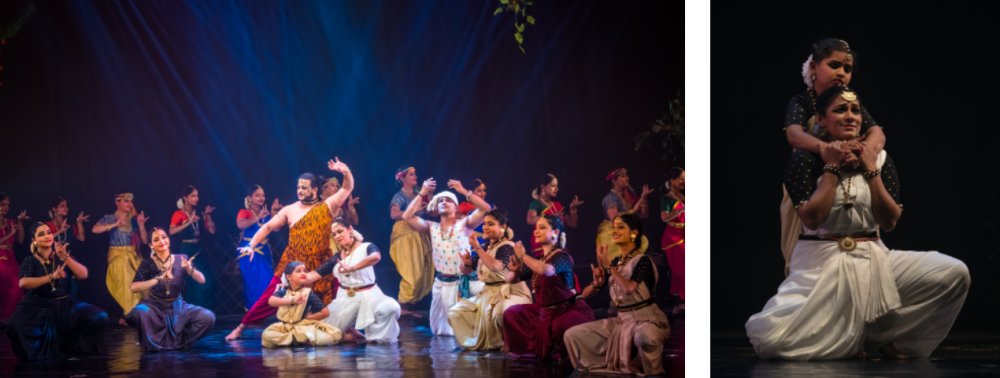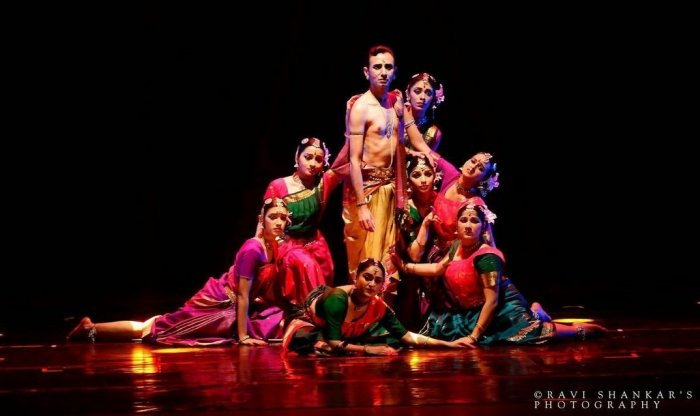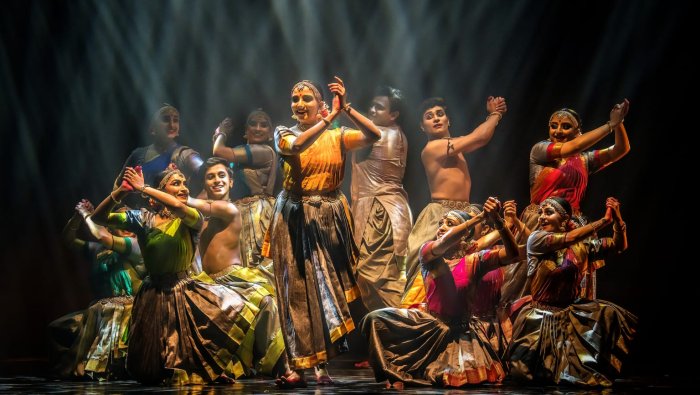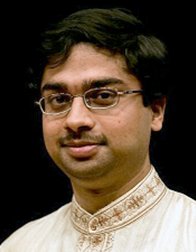
|   |

|   |
19th Drishti Dance Festival: Enrapturing and educating - Arjun Bharadwaj e-mail: arjunbharadwaj@gmail.com February 6, 2024 Bangalore witnessed the Drishti Dance Festival on 20th January this year. This was the nineteenth edition of the veritable artistic treat that has been provided to the connoisseurs of classical arts for close to two decades by dancer Anuradha Vikranth and her husband Vikranth. Ably supported by the students of the Drishti Arts Centre as well as connoisseur-patrons, the evening was a brilliant showcase of four thematic choreographies by different dance ensembles. The primary motif of the festival was the communication of a message for the welfare of the individual and society. As required by the Indian aesthetic tradition, the message was not explicitly expressed but was implicit as an underflowing current in the choreographies. The presentations successfully enraptured the hearts of the audience and helped positive values dawn upon them - it was truly a kāntā-saṃhita.  Saha Dance Ensemble The first sequence was a beautiful episodic portrayal of the concept of ariṣaḍvargas - the six enemies, internal to every human. The four dancers, Gowri Sagar, Sandhya Udupa, Padmini Upadhye, and Divya Prabhath, all endowed with creative acumen and an intuitive eye for aesthetics portrayed six different episodes that highlighted six unbridled emotions and the dire consequences they result in. Urvashi's love (kāma) for Arjuna, which compromised on dharma, led to him being cursed. Shiva's unfounded anger (krodha) on the little boy who was guarding his mother's bathing chamber, resulted in the boy's death as well as Parvati's agony; Shiva realised his mistake and undid it, thereby giving birth to Ganesha. Kaikeyi's excessive love for her son and her greed for the status of being the queen mother (lobha) led to Dasharatha's death and the suffering of the entire kingdom of Ayodhya. Ravaṇa's pride and adhārmic love (moha) made him think that Sita could be won over merely by material wealth. Ganga's intoxicating pride in her strength (mada) resulted in her entanglement in Shiva's tresses. Duryodhana's envy (mātsarya) of Pandava's wealth led to his death and the destruction of his own kingdom. These episodes which were ably portrayed by the four artistes put the rasa-sūtra of Bharata into practice. Abstract emotions were embodied in characters and aptly contextualised. The portrayal of the bodily mannerisms of Manthara, Duryodhana, and Ravana were particularly noteworthy. The artistes also succinctly captured through āṅgika the vigorous flow of River Ganga embodied as a divine lady and depicted the manner in which she slowly and steadily gets streamlined by Shiva in his jaṭā-jūṭa. The artistes subtly suggested the subduing of Ganga's pride by appropriate movements that came to the backdrop of suggestive music. The sequence metaphorically captured the importance of streamlining one's energies and emotions. The episodes of lobha, moha, and mātsarya suggest how the negative emotions of a person in power can result in large-scale destruction. In addition to episodic portrayal, the artistes also personified the ariṣaḍvargas in the backdrop. The presentation traversed the vīra, raudra, bībhatsa, bhayānaka, adbhuta, and karuṇa rasas and also captured instances of rasābhāsa and vīrābhāsa. The dancers who were trained in the karaṇas of the Nāṭyāśāstra applied them to the right context in the right proportions - aucitya reigned supreme throughout. The lyrics penned by Shatavadhani Dr. R Ganesh provided the required backdrop for enactment. The poet also captured the irony of Kaikeyi's demand to Dasharatha; she received vaidhavya as śulka because of her lobha! Each one of the ariṣaḍvargas has the potential to be expanded into a larger presentation. The manner in which the four artistes, though belonging to different schools of thought, blended with each other, was exemplary - rasas and values can truly bring people together.  Drishti Dance Ensemble The second choreography was presented by the Drishti Dance Ensemble along with Surya Rao and Nidhag Karunad playing prominent roles. The presentation that was creatively choreographed by Anuradha Vikranth, who also played the role of the main character, reduced the audience to tears of joy and realization of values. The thematic presentation was based on the Kannada song popularly known as Govina Hāḍu ('The Song of the Cow') which has won the hearts of Kannadigas for over eight decades. The song beautifully personifies the values of honesty, integrity, trust, and commitment through a simple, yet profound story connected with a cowherd named Kalinga and his cows, prominent among which is Punyakoti. Once, when Punyakoti is out grazing along with the other cows, the herd is attacked by a tiger named Arbudha. While most of the cows flee and reach their homes, Punyakoti, who is lost in her thoughts of feeding her child is cornered by the hungry tiger. As the tiger is about to tear her apart, Punyakoti requests him to spare her for a while, as she wishes to feed her child one last time and bid farewell to the little one. Though the tiger hesitates for a bit, Punyakoti convinces him by saying that she adheres to the dictum that Truth is Divine. While Arbuda still harbours some distrust, he permits her to go. Punyakoti rushes back home and tells her child that she is entering the jaws of death; she begs the other 'women' (female cows) to take care of her child and insists on going back. Punyakoti, who is committed to her words to the tiger transcends all personal attachments and rushes back to get herself torn apart by the tiger. She becomes a metaphor for the dissolving of ego and attachments to remain true to the promised word. The tiger, who realises the purity of Punyakoti's heart and her commitment to honesty, gives up his cruel nature and even ends his life. Steadfast adherence to dharma can transform even the hearts of the evil. Dharma finally reigns supreme. The choreographer's skill at creativity was seen in each one of the four modes of abhinaya. The production opened with the depiction of the celebration of Saṅkrānti - the harvest season, which also marks the northward movement of the Sun - Saṅkrānti itself represents the dawning of rays of wisdom on the humans. The costumes, stage properties, and movements were a blend of the nāṭya-dharmī and loka-dharmī; the various colours used to depict the cows suggested the various breeds which were housed together in the cowherd's cottage. The vocabulary of the Nāṭyaśāstra was creatively integrated to represent not only the movements of the human characters but also the animals. The entry of the tiger from the far end of the auditorium enabled the audience to be a part of the presentation and artistically converted the entire area into a performing space. The music that was conceived by Mahesh Swamy was based on the popular tune but was beautifully reimagined for the current presentation. The music brought in the required pauses and emphasis on specific words to create a dramatic effect. Based on the ragas Natha-bhairavi and Charukesi, the music touched the heart of the audience. Though the lyrics were in Kannada, emotions transcended language. The sattva of Punyakoti, her little child, the ferocious tiger, the kind cowherd, and the other caring cows left a lasting mark on the rasikas. Mādhurya and prāsada guṇas, sweetness and tranquillity were present in each aspect of the choreography. The presentation, which was staged as a tribute to Dr. TM Manjunath, the father-in-law of Anuradha Vikranth, in fact, graduated to become a tribute to profound human values. The presentation will amply qualify as a holistic and aesthetically rich rūpaka, even when seen from the perspective of the Nāṭyaśāstra and the Dhvanyāloka.  Chithkala Dance Ensemble The third presentation was by the Chithkala Dance Ensemble led by Praveen Kumar. The production titled Ṛtu-vismṛti was rooted in Ṛtu-saṃhāra, a classic on the six seasons by the poet par excellence Kalidasa. The production started with Praveen Kumar, who depicted the character of Kalidasa enjoying the beauty of the Vasanta-ṛtu, the Spring season on his mental plane. The choice of depiction of this season, which is hailed as the king of seasons, was apt because nature is in her most joyful state in this period. Dancers personified as bees and flowers, filled the stage with brilliant colours and cheerful movements. The dazzling colours, movements, and fragrances set the right context and act as uddīpana-vibhāvas for the entry of Manmatha, the deity of Love; only a serene atmosphere can kindle love, after all. The artiste succinctly presented the attributes of Manmatha and the effects he has on the hearts of every being. While the first part of the production was a depiction of the ideal and most delightful state of nature, the second half portrayed a case of absence of love; the selfishness of humans and their lack of love towards nature kills the spirit of every being. Kalidasa who was depicted to have been transported to today's world could not believe that Vasanta is not visible currently; he realises that his Ṛtu-saṃhāra, which was meant to depict the natural harmony of seasons and humans has turned into another kind of saṃhāra, the slaying of nature by the human greed. The production suggestively showcased that we will have nothing left to celebrate if we destroy nature; being disrespectful to nature will mean our own deaths. In his choreography, Praveen Kumar interspersed spoken words along with musical accompaniment. This was a great value addition to the production and enabled the artiste to communicate directly with the audience. Praveen not only excelled in his fine movements but also his emotive rendition of monologues in Sanskrit and English. The live music ensemble which consisted of Raghuram, Vinay Nagarajan, and Vivek, helped bring dramatic effect to the entire sequence. The music was so creative that even the sollukaṭṭus were endowed with the dramatic element - while in a few instances, they represented the sweetness of nature, in others, they captured the man-made hazards of pollution. The play of light and smoke added to the multi-dimensional experience. The production can serve as a model to all artistes for the manner in which a classical work of Sanskrit literature can be contextualized to communicate a message for the current day without compromising on classical aesthetics.  Ayana Dance Ensemble The final presentation by the Ayana Dance Ensemble appeared to be the most-awaited one by the younger generation of the audience. In the first composition, artistes presented the concept of the five pious women - pańca-kanyās and attempted to present their agony through crisp movements. The second composition was based on the opening verse of Dr. DV Gundappa's Mankutimmana Kagga, which, in a profound manner, captures the philosophy behind the creation of the universe. The verse, which is challenging for any dancer because of its abstract nature, was handled with immense confidence and conviction by the artistes. The final composition threw light on the personal experiences of the artistes and the kind of strength one can derive from the Divine and human society. The compositions received roaring applause from the audience at many junctures. While sattva was dominant in the first three dance ensembles, the Ayana Dance Ensemble appeared to be an embodiment of extreme quantity of rajas. The Drishti family felicitated senior Guru MR Krishnamurthy, the founder of Kalakshiti, a renowned dance institution in Bangalore. Fondly known as 'Kittu sir,' the octogenarian has trained no less than four generations of dancers. The felicitation of this stalwart was a humble gesture of the Drishti family in paying gratitude to senior artistes and conservers of tradition. As Praveen Kumar mentioned in his thanksgiving, January has become synonymous with the Drishti Dance Festival. Rasikas can't wait to witness its twentieth edition in 2025.  Arjun Bharadwaj is a Sanskrit scholar with deep interest in literature, philosophy, and aesthetics. As a poet, he has penned numerous compositions for dance and theatre productions. Well-versed in Sanskrit, Kannada, English, Greek, and German languages, he has authored and translated over fifteen works, which have gained renown around the world. |